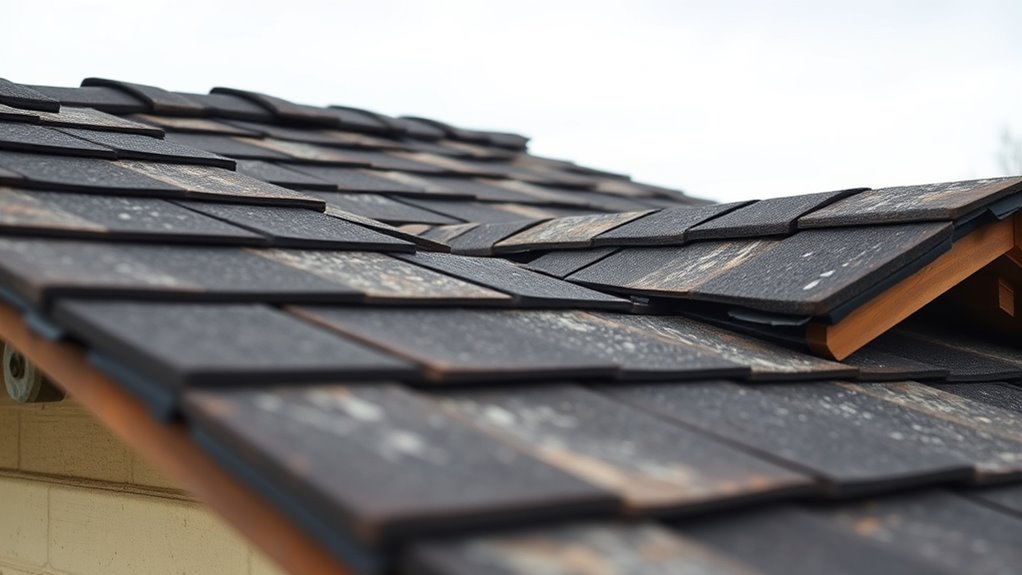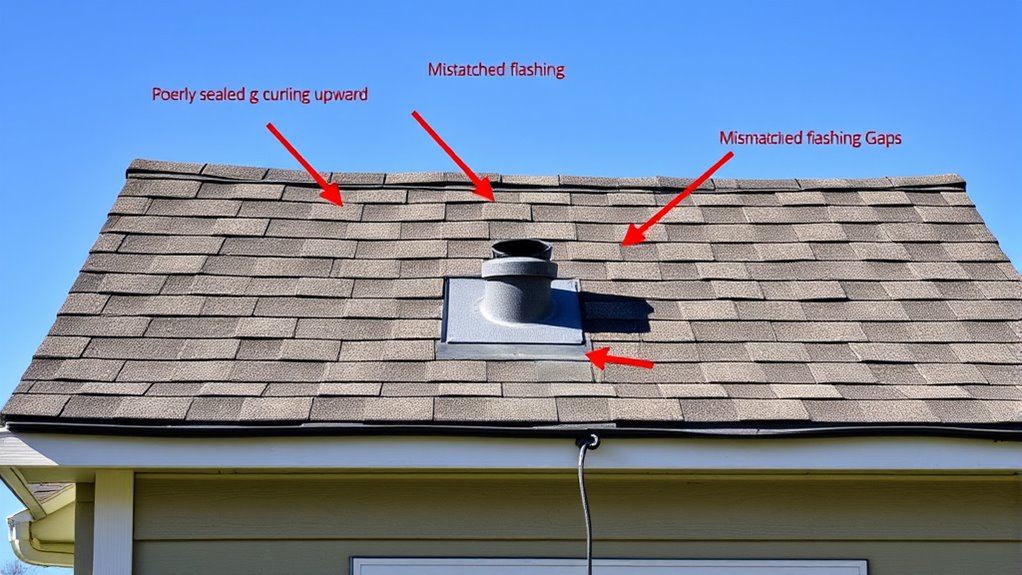In small builds, you often make roofing mistakes like poor ventilation, improper flashing, or faulty shingle application, which can lead to leaks, mold, and structural issues over time. Neglecting regular inspections and maintenance worsens these problems, increasing repair costs. Rushing the installation or cutting corners causes long-term vulnerabilities. Paying attention to these common issues now helps prevent costly repairs later—keep going to discover how to avoid these mistakes altogether.
Key Takeaways
- Poor ventilation causes moisture buildup, mold, and structural damage over time.
- Incorrect flashing installation allows water seepage, leading to leaks and interior damage.
- Improper shingle application and underlayment compromise roof durability and water resistance.
- Neglecting regular inspections and maintenance can let small issues escalate into major repairs.
- Rushing or cutting corners during installation increases vulnerability to weather and long-term damage.

When it comes to small builds, roofing mistakes can quickly undermine your project’s durability and appearance. One of the most common issues you’ll face relates to ventilation. Poor ventilation doesn’t just affect comfort; it can cause serious damage over time. If you neglect proper airflow, moisture gets trapped in your attic or roof space. This trapped moisture leads to mold growth, wood rot, and even structural weakening. Additionally, inadequate ventilation accelerates temperature fluctuations, which can cause roofing materials to expand and contract, increasing the risk of cracks and leaks. To prevent these problems, ensure your roof design includes sufficient intake and exhaust vents, and verify they’re correctly installed. Ignoring ventilation can seem minor initially, but the long-term consequences are costly and compromise your roof’s integrity.
Another critical mistake involves flashing errors. Flashing is essential for directing water away from vulnerable areas of your roof, such as chimneys, vents, and valleys. When flashing isn’t installed correctly or is damaged, water can seep into these seams, leading to leaks and water damage inside your home. You might notice signs like stained ceilings or peeling paint, but often the damage is hidden until it’s extensive. Proper installation requires precise measurement, secure fastening, and using durable materials compatible with your roofing system. Failing to do this not only invites leaks but can also cause corrosion of the flashing itself, further weakening the waterproof barrier. Many small-build projects overlook or rush flashing installation because it seems straightforward, but cutting corners here can lead to significant problems down the line.
Beyond these issues, you should also be cautious of other common mistakes, such as improper shingle application, insufficient underlayment, or neglecting to seal roof penetrations. However, ventilation problems and flashing errors are particularly insidious because they often go unnoticed until they cause visible damage. Regular inspections can catch these issues early, but the best approach is to ensure they’re correctly addressed during installation. Take the time to verify that your ventilation system is well-designed and that flashing is properly installed and maintained. Doing so saves you money, prevents headaches, and extends the lifespan of your small build’s roof. Remember, a well-ventilated, properly flashed roof is the foundation of a durable, weatherproof structure that stands the test of time.
Frequently Asked Questions
How Can I Prevent Leaks in Small Roof Structures?
To prevent leaks in small roof structures, you should guarantee proper ventilation issues are addressed, which helps reduce moisture buildup that can cause leaks. Additionally, install effective drainage solutions, like properly sloped surfaces and clear gutters, to direct water away from the roof. Regular inspections and maintenance also help catch potential problems early, preventing small issues from turning into costly leaks.
What Are the Best Roofing Materials for Small Builds?
For small builds, you want roofing materials that combine durability, affordability, and ease of installation. Asphalt shingles, metal roofing, and rubber membranes each offer unique benefits. Compare these roofing materials by examining their lifespan, maintenance needs, and weather resistance. Focus on proper installation techniques to maximize their performance. By choosing the right material and installing it correctly, you’ll guarantee your small build’s roof stays protected and long-lasting.
How Often Should Small Roofs Be Inspected for Damage?
You should schedule roof inspections at least twice a year, ideally in spring and fall, to catch damage early. Regular inspections help with damage detection methods like visual checks for missing shingles, moss, or leaks. After severe weather, perform an additional inspection to guarantee your small roof stays in good condition. Staying consistent with your roof inspection schedule allows you to address issues promptly and extend your roof’s lifespan.
What Is the Average Lifespan of Roofing in Small Structures?
On average, your small building’s roof lasts about 20 to 30 years, depending on the roofing material used. Metal roofs can endure up to 50 years, showcasing high durability, while asphalt shingles typically last 15 to 20 years. The key to maximizing roofing durability and material longevity is regular maintenance and selecting quality materials. Proper care guarantees your roof stays functional and looks good for decades, giving you peace of mind.
Are There Cost-Effective Roofing Options for Small Projects?
Yes, there are cost-effective roofing options for small projects. You can explore affordable options like asphalt shingles or metal roofing, which provide durability without breaking the bank. DIY solutions are also available, allowing you to save on installation costs. Just guarantee you follow proper guidelines to avoid mistakes and ensure your roof’s longevity. With careful planning, you can achieve a reliable, budget-friendly roof that protects your small build effectively.
Conclusion
Avoiding common roofing mistakes in small builds isn’t just about saving money; it’s about ensuring your roof lasts. Some say small roofs aren’t as vulnerable to issues, but that’s a myth. Proper installation and regular maintenance are essential regardless of size. Trust the evidence—skipping these steps can lead to costly repairs down the line. Take the time to do it right; your small build will thank you with durability and peace of mind.









